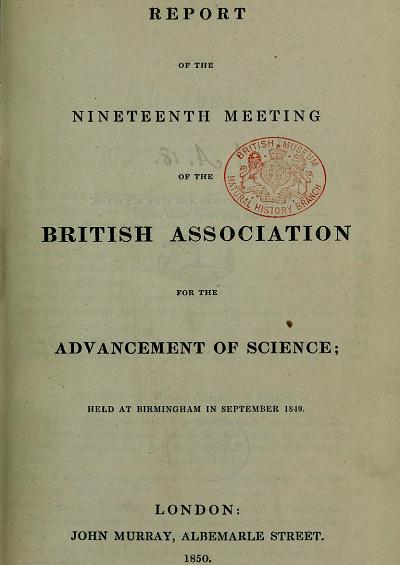STAUROMEDUSAE UK
An online guide to the Stalked jellyfish (Stauromedusae) found
around the coastal waters of the United Kingdom and Ireland.
Includes notes on their identification, and where and how to find them.
On Lucernaria inauriculata. By Professor Owen, M.D., F.R.S.
Professor Owen communicated a description of the external characters and anatomy of a Lucernaria which he had found near low-water mark on the flat rocks to the east of Dover, August 1849, attached to the Ulva latissima: it differed from the Lucernaria quadricornis, or L. fascicularis, in having the eight tentaculiferous lobes equidistant from each other, and it differed from the Lucernaria auricula in the absence of any ear-like appendage at the middle of the border of the connecting webs between those lobes. It differed from the Lucernaria campanulata in the absence of the "two series of foliaceous processes arranged on each side of a white line*," extending from the sides of the mouth along the middle of each connecting web; and by the presence of a convoluted coloured filamentary body extending from the circumference of the mouth to the tentaculiferous extremity of each of the eight lobes. It also differed from the L. cyathiformis in the tentacles being supported, in clusters, at the extremity of lobes produced beyond the margin of the infundibular disc.
The specimens varied from an inch to half an inch in length. One variety had ten lobes. The stem of the polype, which is ordinarily slender and as long as the expanded body, terminates in an adhesive disc or base, in the centre of which is a small triradiate pore or pit, with a thickened border or sphincter. There is no cartilaginous lamina in this disc. Four canals commence from the central pore or pit, and ascend the stem projecting into the central digestive cavity, but separated from the cavity by its lining membrane, which is reflected upon the four canals; forming as many longitudinal folds projecting into the digestive cavity.
* Johnstone's British Zoophytes, 1846, p. 249, fig. 56, b.
The four canals bifurcate, and are continued along each of the eight lobes to their extremities, where they subdivide, and are continued along each of the thirty or thirty-two tentacles forming the terminal cluster of the lobe. Professor Owen described a small triradiate pore at the round expanded end of each tentacle, and assigned reasons for regarding it as the orifice of the canal traversing the tentacle. He entered into a disquisition as to the function of this system of ramified canals, which is equally distinct from the digestive and generative systems, and contains a clear colourless liquid, with minute organic particles or granules; and expressed his opinion that the system of ramified canals was homologous with the partially-divided abdominal or aquiferous cavity from which the canals of the tentacula are continued in the Actiniae.
The generative organs were arranged in eight filamentary masses, disposed in short wavy folds along the inner surface of each of the eight lobes. Each mass consists of a central lobulated body containing the fusiform capsules of the spermatozoa, similar to, but smaller than those of the Actiniae, and this body is surrounded by the looser stroma containing the ova. The large mature and impregnated ova dehisce from the inner surface, or that next the cavity of the infundibular web of the polype.
Professor Owen having travelled from Dover to the meeting at Birmingham, had not had the opportunity of comparing his observations with those of any other author, except such as were given in Dr. Johnstone's excellent work on ' British Zoophytes,' — the best manual for the sea-side observer. In reply to some remarks respecting the four longitudinal muscles or ligaments, described by Sars and others as rising up within the pedicle, he remarked that nothing was easier or plainer than the demonstration of the areas of four corresponding canals in his Lucernaria: it required only a neat transverse section of the stalk or peduncle to see that they were not solid, but hollow bodies. The pores on the clavate ends of the tentacles were best seen by viewing them as opake objects with a good reflected light.
Since making the above communication, the author has compared his species with all the extant descriptions and figures of Lucernaria, and finds so close a resemblance in that figured in the late French illustrated edition of Cuvier's 'Regne Animal,' as to lead him to conclude that it is the same species. It is referred in that work, however, to the Lucernaria auriculata, although differing, like the Dover specimens, in the absence of the ear-like appendages to the webs signified by the name. If those appendages be constant, the specimens described by Prof. Owen, as well as that figured in the 'Regne Animal,' are a distinct species, for which the name Lucernaria inauriculata is proposed.
------------------------------------------------------------------
The species described here is Calvadosia campanulata. Lucernaria inauriculata was proposed here because the specimen was wrongly dismissed as being Lucernaria campanulata, and because there was early confusion between Lucernaria campanulata and Lucernaria convolvulus. The latter, now Craterolophus convolvulus was figured for Lucernaria campanulata by Johnstone. Lucernaria campanulata now being known as Calvadosia campanulata.
